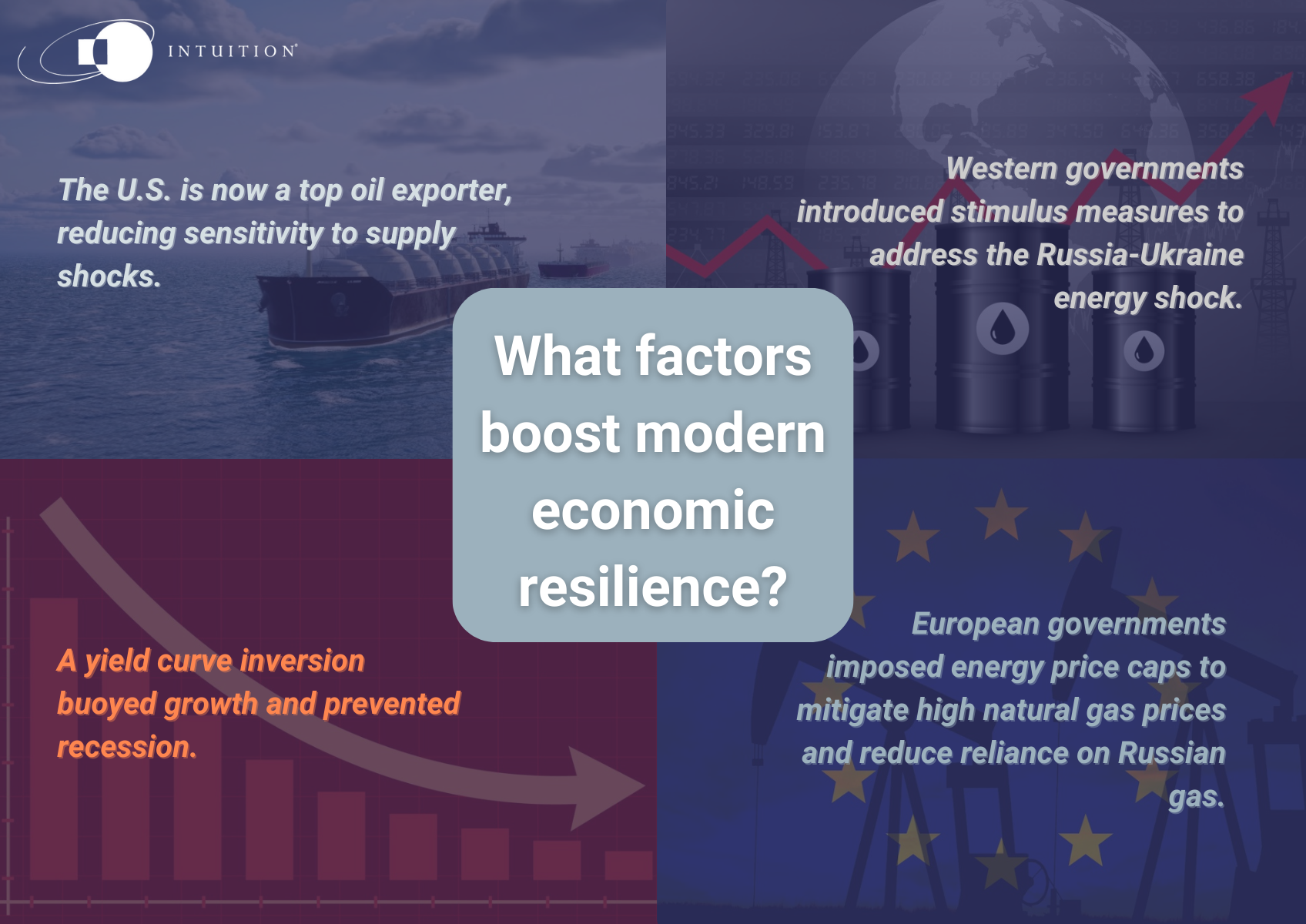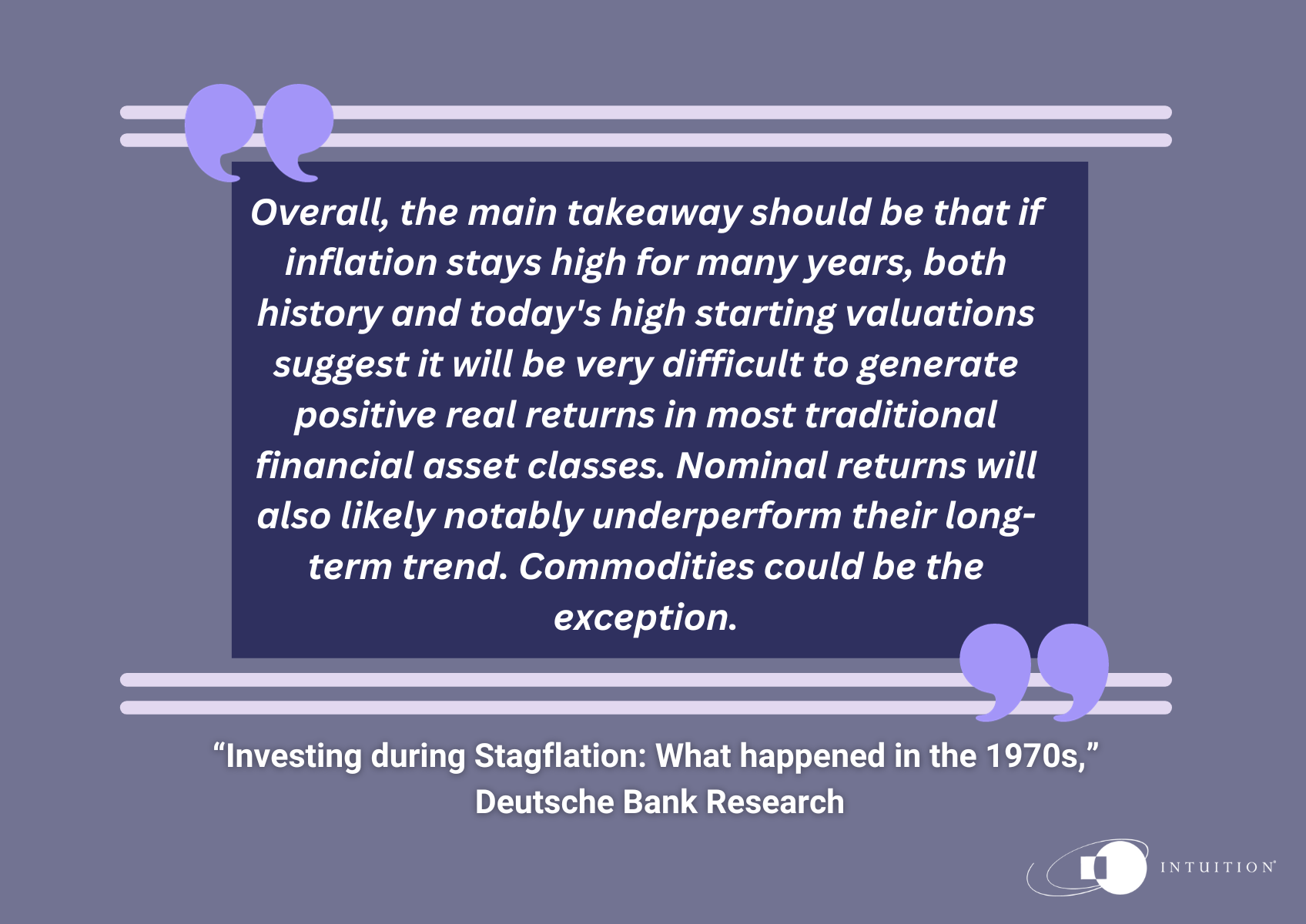Specter of stagflation haunts markets
The response of central authorities to the pandemic was decisive – reflationary policies that injected massive amounts of money into both the financial system and the real economy, turbocharging credit growth and asset valuations. However, the unintended consequence of all this stimulus was an unwelcome surge in inflation, exacerbated by the energy price shock caused by Russia’s invasion of Ukraine in February 2022. High and persistent inflation forced a sharp shift from a highly accommodative monetary policy stance to aggressive monetary tightening. These measures have already caused considerable stress in markets, with potentially much more to come.
Inflation remains persistent throughout the globe, while growth has stalled in many regions, having proven far more resilient than anticipated. This combination has raised the specter of a phenomenon not seen since the 1970s – stagflation, which is a combination of low economic growth, rising prices, and high unemployment.

Echoes of the 1970s
The echoes of the 1970s are clear. The shockwaves that Russia’s invasion of Ukraine in February 2022 sent through energy markets were starkly reminiscent of the oil price shock of 1973, when Arab nations imposed an oil embargo on the US and other countries that supported Israel in the Yom Kippur War. The alarming recent breakout of violence in the Israel-Gaza conflict has clear resonance too. A common feature of both energy price shocks is that they made an existing inflation problem worse.
The policy responses to the inflation shocks were also similar. In 2022, as in the 1970s, the US Federal Reserve was forced to maintain an aggressive monetary tightening stance – the rate hiking cycle that began in early 2022 may not yet have run its course.

Important differences
However, there are important differences. While the 1970s oil price shock and the subsequent policy response plunged the US and much of the world into recession, developed economies have so far proven much more resilient to the more recent shock.
There are several likely reasons for this resilience.
First, unlike in the 1970s, the US today is a net exporter of oil, and therefore much less sensitive to global supply shocks.
A second factor was a raft of stimulus measures implemented by Western governments aimed at countering the effects of the Russia-Ukraine energy market shock. The US government passed the so-called Inflation Reduction Act, which included (among other measures) a release of the US strategic petroleum reserves (SPR), helping to alleviate supply shortages and drive oil prices lower. Meanwhile, energy price caps imposed by European governments helped to cushion the blow of soaring European natural gas prices, with the Russian gas tap effectively turned off.
A third development that may have buoyed growth and helped to avert recession was a pronounced yield curve inversion (short-term interest rates rising well above long-term rates), which helped to anchor long-term borrowing costs.
The upshot of these various measures was that unlike in the 1970s, recession was avoided. Growth across developed markets even surprised to the upside heading into 2023, as inflation abated and, crucially, the labor market in the US showed no signs of weakness. This backdrop set the stage for strong gains in risk assets through to July 2023.

Renewed storm clouds
However, clouds soon started to gather again. Following sharp declines, oil prices found a footing in July-August and have been rallying since, driven by a combination of buoyant demand, OPEC production cuts, and the US government buying oil to replenish the depleted SPR.
This pick-up in the oil price has coincided with inflation creeping higher again, with successive CPI readings above 3.5% in recent months – the first negative surprises since 2022. The stubbornness of inflation was one of a handful of factors (another being heavy supply from the US Treasury) contributing to a bond market rout over the summer, in which long-dated bonds bore the brunt of the selling. The resultant yield curve steepening has undone much of the prior inversion, causing ructions in bond markets as markets priced in “higher for longer” interest rates.
Meanwhile, growth has shown signs of slowing. This current backdrop – a weakening economy amid stubborn inflation, with rising oil prices, and a steepening yield curve – is exactly what stagflation looks like.
Countervailing deflationary forces
Before we get to what a new era of stagflation might mean for financial markets, it’s important to note some powerful forces acting against it. A big one is China, which is currently in the process of unwinding its real estate bubble built over decades. This has caused debt deflation, with echoes of post-bubble Japan of the 1990s.
Another is the outsized national debts and deficits in the developed world – most importantly, the US. An adjustment needs to happen, and the IMF, among others, has been urging governments to rein in their deficits. It’s hard to imagine inflationary pressures persisting in a world where China exports deflation while the US and other governments get serious about reducing their deficits, effectively reversing the various stimulus measures that drove much of the inflation in the first place. And even if governments don’t get serious about deficit reduction, this may only force central banks to hold rates even higher for even longer, which should then keep a lid on inflation
Market implications
Assuming stagflation were to prevail, despite the deflationary winds described, what might the implications be for financial markets?
Stagflation is generally bad for bonds and most financial assets, but good for real assets, such as commodities. On the face of it, then, investors should shun bonds and buy commodities, commodity-related equities (oil and mining stocks, for example), and the equity markets of commodity exporters, such as Brazil, South Africa, and Australia.
However, starting valuations must also be considered – what are these different assets pricing in? Having taken a severe beating since the end of 2021, bonds have priced in a lot of the bad news. US Treasuries are now offering positive real yields (nominal yields minus inflation – compare 4.8% on 10-year USTs, for example, to current CPI around 3%). In other words, inflation would have to rise almost two percentage points from here to erode this positive real yield, leaving a decent margin of safety for bonds. The same cannot be said for US equities, which are looking expensive in most scenarios, pricing in decent earnings growth over the next two years, and therefore highly vulnerable to negative growth surprises.
What about those inflation/stagflation beneficiaries – commodities, Brazil, and so on? While these markets have outperformed over the past two years, they are still a long way from undoing their dramatic underperformance versus US equities experienced during the disinflationary post-financial crisis period. This leaves them looking relatively cheap, at steep discounts to US equities, with plenty of catch-up potential should inflation/stagflation persist.
A Deutsche Bank report from last year on those parallels between the current environment and the 1970s sums up as follows:

To sum up, then, this is a complicated environment with all sorts of variables. Nobody knows what sort of regime will prevail. However, whether it’s stagflation or something else, the unusual mix of ingredients in play means there’s a decent chance it will be one most market participants are unaccustomed to.
Intuition Know-How has a number of tutorials relevant to the content of this article:
• Inflation – An Introduction
• Inflation Indicators
• Commodities – An Introduction
• Commodities – Crude Oil
• Commodities – Natural Gas
• Monetary Policy
• Fiscal Policy Analysis
• Bond Markets – An Introduction
• Yield Curves – An Introduction
• Equity Markets – An Introduction
• Equity Valuation – An Introduction


